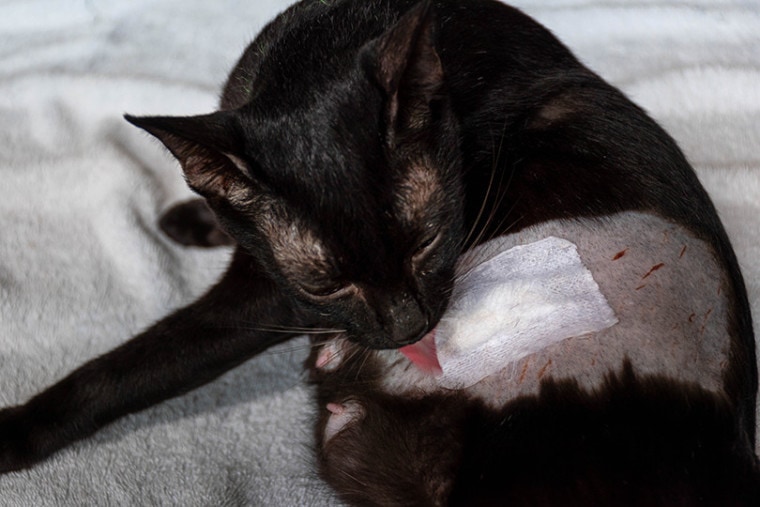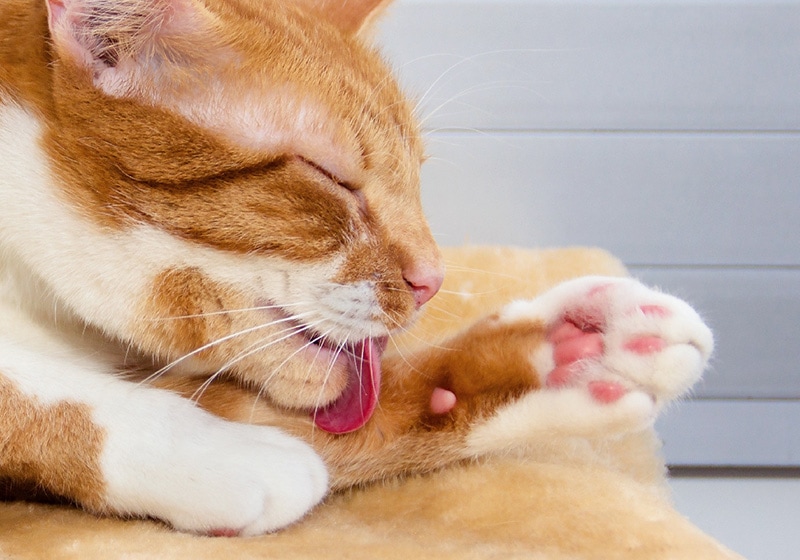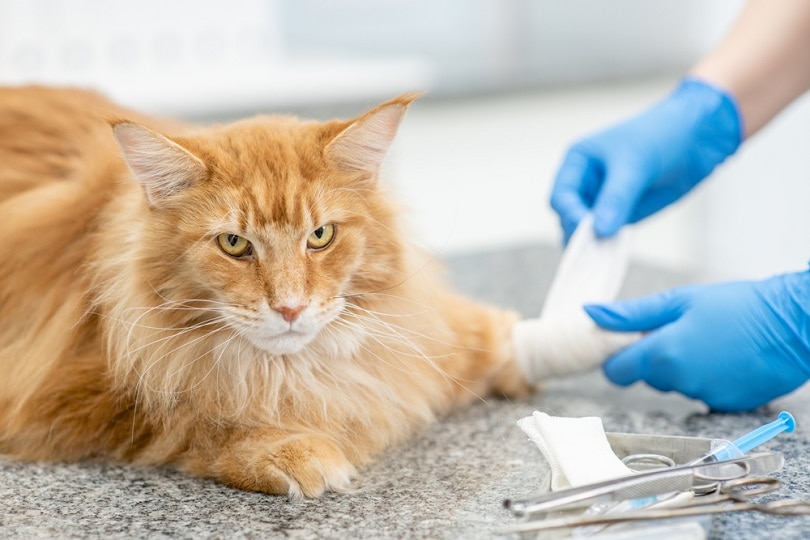
Wounds are a normal part of life for all living creatures. As a fellow cat lover, you’ve probably heard a time or two that you shouldn’t allow your cats to lick their wounds. Even though it seems to comfort them, it can only make the injury worse if you allow this behavior to continue. It can be a bit challenging to stop your cat, but it’s necessary in order for them to recover quicker and get back to their normal self.
Why Do Cats Lick Wounds?
There are several reasons why cats try to lick their injuries. Think of their wound similar to one of yours. For example, after getting spayed or neutered, your cat’s skin starts to scab and the hair regrows. The affected area is itchy while healing, and it feels good to scratch it. Cats are very particular about their hygiene, and licking a wound may help remove dried-up blood or discharge as an attempt to keep it clean, as well as to soothe and comfort them in the process. Unfortunately, this could jeopardize the healing process and you’ll have to step in and prevent them from continuing.
Cats could also be licking a fresh wound to try to keep it clean. Unfortunately, this could jeopardize the healing process and you’ll have to step in and prevent them from continuing.

Caring for Cat Injuries
Fresh wounds range from minor to more serious. If your cat has a very small, superficial scrape that has already dried up and started scabbing over, make sure to clean it up with warm water or a mild antiseptic wound-cleaning solution that your vet will give you, and it should start to heal on its own time. Send your vet a picture of the wound, so they can advise you if your cat needs to be seen.
Deeper or wider cuts or injuries always require a trip to the vet for cleaning and systemic treatment with antibiotics and painkillers, depending on the extent, and sometimes even sutures to keep it closed. If you’re unsure about what to do, the vet is always the best person to assess the situation and determine what kind of treatment is needed.
The 3 Ways to Keep a Cat From Licking Its Wounds
Cats are determined animals, and stopping them from doing things they want to do is a challenge. What are some helpful options if you can’t get your cat to stop licking their injuries? Let’s take a look at some of the best cat-licking deterrents.
1. Bandage the Area
One of the ways to get your cat to stop licking a wound is to wrap a bandage around it. However, only a vet should apply a bandage on your cat’s wound after thorough cleaning and wound flushing, as not all wounds require bandaging. If your cat has a bleeding wound, this is an example where you should apply a pressure bandage to stop the bleeding, while simultaneously getting your cat to the vet.
Some wounds need to stay uncovered, and bandaging them may cause complications, such as wound infection or sores. Wound dressings need to be changed regularly, often on a daily basis, and your vet will instruct you on the frequency of these changes. They will show you what materials to use and how to apply them safely.
Ensure that the dressing you use is dry and clean. Always make sure the bandage is not tight, as it may compromise your cat’s circulation and lead to significant pain and sores. If the bandage gets wet, it should be removed. Some cats continue to lick or chew on the bandage until it’s destroyed. This behavior can be due to pain or a sign the bandage is too tight, although some cats will remove them just because they’re annoyed with having something on their skin. There is also a way to stop this from happening. Cats with a bandage should always stay indoors until their wound is healed, and make sure they do not eat the pieces of the bandage materials, as this may cause a stomach upset or even a blockage.

2. Use an Elizabethan Collar
E-collars are commonly used for all animals that have recently undergone surgery or suffered from some sort of injury. These collars wrap around the cat’s neck gently and moderately loosely and make it harder for them to reach the affected area. They look like a lampshade and block them from reaching the wound.
E-collars can be made from plastic, fabric or even come as inflatable soft collars, and each is more suited to a certain kind of wound and their location, as the most important function of the collar is preventing the cat from licking or scratching their wound. They’re very effective, and it may take a couple of days for the cat to adjust to it.
Your cat should be able to eat and drink with the protective collar on, or alternatively, you can remove it during this time and supervise your cat to make sure they’re not licking. Again never let your cat out of the house with a collar on, as their ability to navigate the open space and estimate danger is reduced, and they can get hurt. Speak to your vet about the best type of E-collar for your cat, depending on their wound.
3. Consider an Appropriate Body Suit
Final options that may work for some cats are onesies or bodysuits. Many cats hate them, as they feel restricted and dislike something touching their skin, while others prefer them to e-collars. Speak to your vet as they may apply one to your cat while they are recovering from their neutering or other surgery. This way, they will be able to tell if your cat is tolerating a body suit, or if they would be a better candidate for an e-collar.
Bodysuits can only be used to prevent the cat licking wounds on their chest and abdomen, which is covered by the suit and not the legs, which are left out. Your cat may need a few of these if they get wet when they toilet.

Why It’s Important to Stop a Cat From Licking Their Wounds
Cat saliva actually does contain some antibacterial properties that may help them in the wild by reducing bacterial growth and promoting healing. However, the disadvantages of licking far outweigh the advantages.
Saliva isn’t the only thing that’s left behind while your cat licks themselves.
Regardless of the antibacterial properties, it is still mixed in with a dirty mouth that is rarely brushed. Bacteria still lingers in your cat’s mouth and gets left behind, while some of these bacteria also pose a health risk for humans. Cat’s may be notorious for their grooming habits, but think about all the unsanitary places that they spend cleaning. All of these germs end up in their mouths, and the last place you want those germs to end up is on an open wound. If you don’t keep the wound free from bacteria, you’re just asking for an infection.
Another important aspect when it comes to cats licking their wounds is their perseverance. Cats are very persistent when it comes to licking their wounds, and they will do it excessively, causing irritation and damage to the skin and tissue, which actually impairs healing.
What Happens if a Wound Gets Infected?
Infections may turn to painful abscesses and, in some cases, if left untreated, can lead to severe or even potentially life-threatening problems if the infection spreads throughout the body or enters the chest or abdomen. Signs of an infected skin wound include one or more of the following:
Final Thoughts
Even though our cats think they can take care of themselves, we are their guardians and have to act in their best interest to keep them safe. It can be tempting to let them do whatever they want to do, but veterinary guidance and your supervision is crucial for speeding up the wound’s healing process and getting them back to normal.
Next on your reading list:
- Can I Use Hydrogen Peroxide on My Cat? Vet-Approved Advice
- Why Is My Cat Biting Their Feet? Causes, Solutions & FAQs
Featured Image Credit: Cobalt S-Elinoi, Shutterstock





